Isle of Wight, Hampshire
Up to 1834
In 1732, the second edition of An Account of Several Workhouses... recorded the existence of workhouses at Northwood from 1728, and at Brixton and Newport from 1729 (Hitchcock, 1985). The report from Northwood noted that:
Newport is following our Example, and has a Work-house to be opened at St. Thomas's Day.
Newport's workhouse was on Holyrood Street, opposite its present-day junction with Sea Street. In 1774, its inmates were transferred to the new House of Industry (see below) and the old building was converted to house the Town Gaol and County Bridewell, later a police station.
The Isle of Wight was incorporated in 1771 under a local Act of Parliament (11 Geo. 3. c.43. For establishing a House or House of Industry in the Isle of Wight, for the Reception, Maintenance, and Employment of the Poor belonging to the several Parishes and Places within the said Island). The Act empowered the Incorporation "to manage the poor persons incapable of providing for themselves in the parishes of the island; to let out poor to harvest work" and "to apprehend idle persons not maintaining their families in the island".
The Incorporation was also required to erect "in a plain and durable Manner" a House of Industry "to serve as an Hospital for the Reception of such aged, sick, or infirm Persons, and young Children, as are not able to work; one other Building, or Part of a Building, to serve for the Resection, Maintenance, and Employment of such poor Persons as are able to work; and one other separate Building, or Part of a Building, to serve as a House or Houses of Correction, for the Punishment and keeping to hard Labour such idle and disorderly Persons, who, being able, shall refuse to work, or otherwise misbehave themselves." The House of Industry was erected at a site to the north of Newport. It was a large two-storey L-shaped building in red brick.
In 1782, prison reformer John Howard visited the new workhouse and wrote:
At my last visit there were 65 men, 150 women, 155 boys and 146 girls. The house was neat and clean; and the lodging-rooms were fresh which had apertures in the cielings (18 inches by 12) and those not stopped up. The women's sick ward (28 feet wide) was quite clean, and the beds were not crowded.
The principal work of the house was making sacks, biscuit and nail bags, besides, there were tailors and shoe-makers employed. The provisions were good; the girls and boys were clean, a set of fine healthy children.
The economy of giving them (especially the elderly people) no more of their earnings than one penny in the shilling, is not for the advantage of the house.—Here is a fault (which is common in such buildings), that the dining-hall, work rooms, and bed-rooms, are all too low.—In the passages and staircases of such houses, all expedients should be used to promote the circulation of air.
I observed an excellent contrivance in the windows of the women's sick-ward. By a small hasp in the upper sash and staples in the frames, when that sash is in part, or entirely down; a padlock prevents the nurses or patients putting it immediately up, as they generally do in the county hospitals, and at Plymouth, and Haslar, when the medical gentlemen leave the rooms. Dr. Lind told me that in summer time he nails down some of the sashes in the passages, &c .
The House of Industry's 1792 rule book gives a flavour of life for inmates. Breakfast was at 8am, and dinner at noon, with supper eaten after the end of the day's work. Bedtime was at 8pm in winter and 9pm in summer, with no candles allowed to be lit in the evening between May and August. Clean "linen" (i.e. shirts, underwear etc.) was issued each Saturday evening. The use of tobacco, distilled liquors and tea were prohibited except by direction of the medical officer. The matron instructed the older girls in cookery, housewifery, washing, and scouring, in order to qualify them for domestic service. Unmarried mothers were housed apart from other inmates and had their names entered in a "black book" — they were allowed no solid meat on meat days, and had to wear coarse yellow coats or gowns "or other disgraceful distinctions. On the other hand, those paupers who were judged to have worked "with care and diligence" could receive occasional rewards. The inmates' weekly "bill of fare" is shown in the table below.
| Breakfast | Dinner | Supper | |
|---|---|---|---|
| Sunday | Bread and butter | Boiled beef. | Potatoes |
| Monday | Ditto | Pease, with the beef liquor | Bread and butter |
| Tuesday | Ditto | Bread and butter | Ditto |
| Wednesday | Ditto | Fresh beef soup | Potatoes |
| Thursday | Ditto | Bread and butter, or baked pudding | Bread and butter |
| Friday | Ditto | Potatoes, or green pease, or beans, with fat bacon, or pork, not exceeding 50lbs. | Ditto |
| Saturday | Ditto | Rice-milk | Ditto |
The full 1792 rule book is shown on a separate page.
Eden, in his 1797 survey of the poor in England, gave an extensive description of the Incorporation's operation and of the workhouse building:
The principal part of the building is 300ft. long from east to west, by 27 wide in the clear, having windows on both sides for the advantage of a thorough draft of air; at the distance of 200ft. from the west end, a wing from the main building ranges southward, 170ft. by 24, from the end of which are built workshops for the manufacturers and mechanics, and these with a walk on the west form a square of 200ft. by 170. On the east side of the wing is a court, 170ft. by 50, formed by offices on the north, such as dairy , washhouse, brewhouse, woodhouse, etc. In the principal building is a large storeroom, steward's room, dining-hall, 118ft. long by 27 wide, and a common sitting-room for the impotent and aged. Under the east end there are cellars for beer, meat, etc. Over this are the governor's and matron's lodging rooms, the laundry nurseries and sick wards. In the wing on the ground floor are the school rooms, apothecary's shop, kitchen, scullery, bakehouse, bread room, governor's and matron's sitting room and pantry ; and over are the lying-in rooms, sick wards and 20 separate rooms for married men and their wives, with two common sitting-rooms adjoining for the old and infirm who are unable to go downstairs. In front of the principal building is a large gateway on the east side of which is a master weaver's room and spinning room, 96ft. by 18, with storerooms over it; at the west side of this gateway are the shoemaker's and tailor's shops, with a spinning room, 150ft. by 18, with weaving rooms and storerooms over. The chapel is on the north side of the principal building; over it is a storeroom. Four hundred yards distant is a pest house, with a burying ground, walled in, close adjoining. To the north of the pest house is a building for persons under inoculation. It consists of 4 rooms, 15ft. by 14. On the south is a large garden which supplies the house with vegetables. On the east behind the offices are the hogsties, barn, stable and other outhouses. The house can accommodate 700 people, but the number seldom exceeds 550. On Ap. 3, 1796, there were 86 men, from 20 to 90 years of age, cripples, blind, idiots, etc. 115 women, from 20 to 90 years; the younger part are blind, etc., or sent hither in cases of bastardy. 131 boys from infants to 13 years, among whom are many cripples. 163 girls from infants to 13 years, cripples, etc. The manufacture in the house consists chiefly in making sacks for coal, flour and biscuits, besides which lindsey, kerseys, etc., are made for the use of the house.
After 1834
Because of its status as a Local Act Incorporation, the Isle of Wight was exempt from many of the provisions of the 1834 Poor Law Amendment Act and it continued in operation. Its member parishes at this time were: Arreton, Binstead, Bonchurch, Brading, Brixton, Brook, Calbourne, Carisbrooke, Chale, Freshwater, Gatcombe, Godshill, Kingston, Mottiston, Newchurch, Newport, Niton, Northwood, St Helen's, St Lawrence, St Nicholas in the Castle, Shalfleet, Shanklin, Shorwell, Thorley, Whippingham, Whitwell, Wootton, Yarmouth, and Yaverland.
In 1865 it was discovered that there were serious problems with the Incorporation's legal constitution. The Isle of Wight Guardians Act in 1776 (16 Geo. 3. c.53) had allowed the Incorporation's Directors and Guardians to raise money for poor relief, so long as the sums did not exceed the average amount raised for this purpose per annum between Easter 1765 and Easter 1770. A later Act (16 Geo.3 c.43) did permit larger sums to be raised, but only if the average price of wheat at London's Mark Lane corn market rose above the what had been the average price there from 1765 to 1770. The first problem was that no market records for the period survived, the relevant returns having been destroyed by fire. Second, comparable records from Windsor market indicated that the price of wheat in 1865 was lower than what it had been in 1765-70. Since the island's poor law expenditure in 1865 was more than doubled that in 1770, it seemed almost certain that the Incorporation's legal powers were being abused. The Local Government Board happily took advantage of this situation advised the Incorporation to reconstitute itself as a Poor law Union which it did on 14th September 1865. The new union was administered by a 54-strong Board of Guardians representing the union's 3 constituent parishes. Subsequent additions to the union were: Ashey, Cowes, East Cowes, Sandown, East Shanklin, and Totland (all from 1894), and Bambridge (from 1896).
The workhouse location and layout are shown on the 1896 map below.
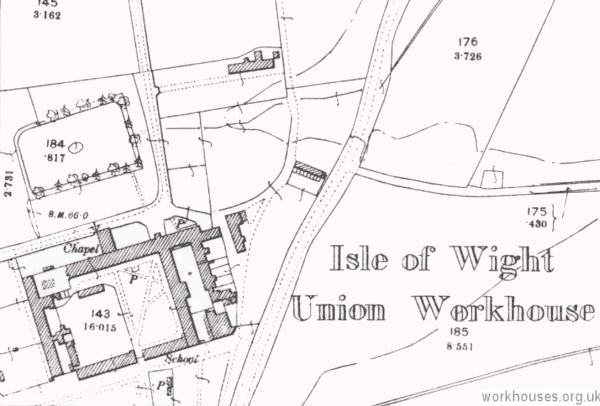
Isle of Wight workhouse site, 1896
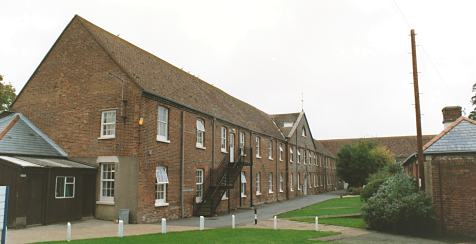
Isle of Wight main building from the south-west, 2001.
© Peter Higginbotham.
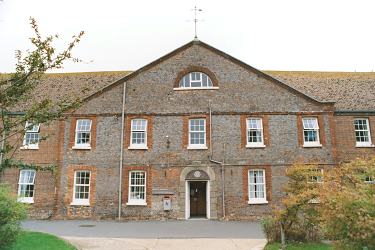
Isle of Wight main building entrance from the south, 2001.
© Peter Higginbotham.
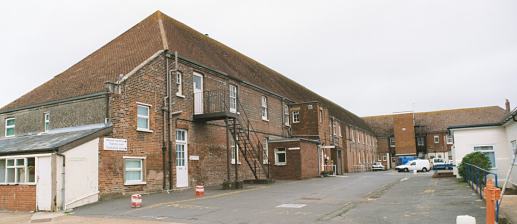
Isle of Wight main building from the south-east, 2001.
© Peter Higginbotham.
A chapel was attached at the north of the main workhouse building.
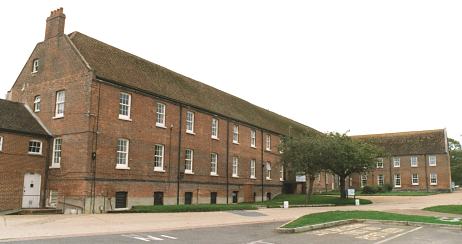
Isle of Wight rear of main building and chapel from the north-east, 2001.
© Peter Higginbotham.
Between 1896 and 1908, a school block at the south side of the building was removed. The original infirmary, at the west of the complex, was replaced by two infirmary pavilions, one for males and one for females.
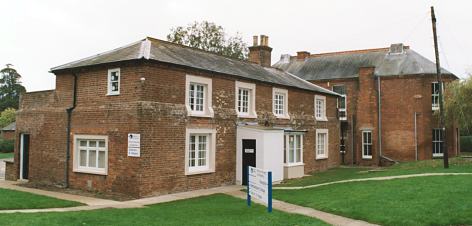
Isle of Wight southern infirmary pavilion from the north-west, 2001.
© Peter Higginbotham.
The workhouse layout in 1908 is shown below.
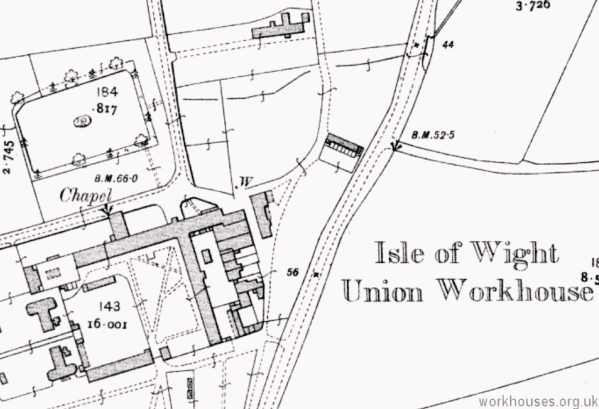
Isle of Wight workhouse site, 1908
The former workhouse buildings later formed part of St Mary's Hospital.
Scattered Homes
By the 1920s, the Isle of Wight Union was operating a number of scattered homes. In 1924, there was a boys' home and a girls' home at Arreton, and a home for infants at Wooton Bridge, each of which held 12 children. By 1929, the boys' home had moved to East Cowes.
Staff
Inmates
Records
Note: many repositories impose a closure period of up to 100 years for records identifying individuals. Before travelling a long distance, always check that the records you want to consult will be available.
- Isle of Wight Record Office, 26 Hillside, Newport, Isle of Wight PO30 2EB. Holdings include Workhouse weekly minute books and outdoor relief lists (1778-1930); Inmate lists (1790-1813, 1820-39); Register of workhouse apprentices (1802-33); etc.
Bibliography
- Shepard, W and Greening, B Life within the Isle of Wight Workhouse (2011)
- Hitchcock, T.V. (1985) The English workhouse: a study in institutional poor relief in selected counties. l695-l750. (D. Phil. thesis. University of Oxford.)
Links
- None.
Unless otherwise indicated, this page () is copyright Peter Higginbotham. Contents may not be reproduced without permission.


